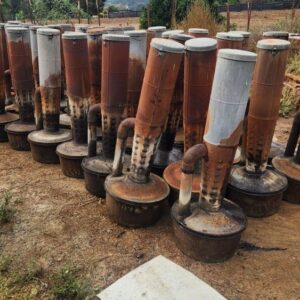Breakthrough in Leukemia Treatment: Targeting DYRK1A in Blast Phase Myeloproliferative Neoplasms
Introduction
Leukemia, a group of cancers affecting blood and bone marrow, remains a significant challenge in oncology, especially when it advances to aggressive forms resistant to treatment. Among these, blast phase myeloproliferative neoplasm (BP-MPN) is particularly devastating, with patients facing rapid disease progression and limited therapeutic options. A groundbreaking study led by researchers at the University of Oxford has uncovered a potential new therapeutic target—DYRK1A—driven by complex genetic rearrangements caused by chromothripsis. Published in Nature Genetics(https://www.nature.com/articles/s41588-023-01456-z), this research could pave the way for novel treatments offering hope to patients affected by this aggressive leukemia.
What Is Blast Phase Myeloproliferative Neoplasm?
Myeloproliferative neoplasms (MPNs) are a group of blood cancers characterized by the overproduction of blood cells in the bone marrow. While some MPNs progress slowly, a subset of patients experience a rapid transformation into blast phase (BP), a form of acute leukemia with an extremely poor prognosis. This progression involves a sudden increase in immature blood cells, known as blasts, which disrupt normal blood formation and lead to severe symptoms such as anemia, infections, and bleeding.
BP-MPN is notoriously resistant to standard chemotherapy and stem cell transplantation, with median survival often less than one-year post-diagnosis. The mechanisms driving this aggressive transformation have remained elusive, hampering the development of effective therapies.

Chromothripsis: A Genomic Catastrophe Driving Leukemia Progression
One of the key discoveries of the Oxford study is the identification of chromothripsis as a major driver of genetic chaos in BP-MPN. Chromothripsis is a recently described phenomenon where chromosomes shatter into dozens or hundreds of fragments, and then reassemble in a disorganized manner. Unlike the gradual accumulation of mutations, chromothripsis represents a one-off catastrophic event causing massive genomic rearrangements.
In BP-MPN patients, chromothripsis frequently causes amplification of a portion of chromosome 21 (chr21amp). This aberrant gain leads to the overexpression of multiple genes in that region, most notably DYRK1A. The researchers found that approximately 25% of BP-MPN patients exhibit this amplification, which correlates strongly with poorer clinical outcomes.
For a detailed scientific overview of chromothripsis, its mechanisms, and its role in cancer, refer to this comprehensive review (https://www.ncbi.nlm.nih.gov/pmc/articles/PMC5839770/).
DYRK1A: The Molecular Engine Behind Leukemia Cell Survival
DYRK1A (Dual-specificity tyrosine phosphorylation-regulated kinase 1A) is a gene encoding a protein kinase involved in numerous cellular processes including cell cycle regulation, DNA repair, and apoptosis. While DYRK1A normally functions in maintaining cellular homeostasis, its overexpression in BP-MPN cells—driven by chr21amp—alters key signaling pathways that favor leukemia cell survival and proliferation.
The Oxford team demonstrated that BP-MPN cells are “addicted” to DYRK1A activity. Experimental suppression of DYRK1A through genetic knockdown or chemical inhibitors significantly impaired leukemia cell growth both in vitro and in animal models, highlighting its potential as a druggable target.
For more information on the DYRK1A gene and its functions, you can visit the official gene database (https://www.ncbi.nlm.nih.gov/gene/1856).
How DYRK1A Promotes Leukemia Progression: Pathways and Mechanisms
DYRK1A’s overactivity influences multiple cancer-promoting pathways. Most notably, it amplifies the JAK-STAT signaling pathway, which is commonly hyperactivated in MPNs and promotes unchecked cell proliferation and survival. DYRK1A also enhances the expression of BCL2, a protein that blocks apoptosis, allowing leukemia cells to evade programmed cell death even in the presence of DNA damage.
Interestingly, inhibiting DYRK1A not only halts cancer cell proliferation but also induces DNA damage and impairs repair mechanisms. This dual impact causes leukemia cells to become more vulnerable to cell death, especially when DYRK1A inhibitors are combined with drugs targeting BCL2 or other survival pathways.
Challenges in Treating BP-MPN and How This Discovery Offers Hope
Treating blast phase myeloproliferative neoplasms has long been a formidable challenge. Conventional chemotherapy often fails due to the disease’s rapid progression and genetic complexity. Stem cell transplants, while potentially curative, are not suitable for many patients due to age, comorbidities, or donor availability. Additionally, targeted therapies used in earlier stages of MPNs tend to be ineffective once blast transformation occurs.
The identification of DYRK1A as a critical vulnerability in BP-MPN offers a much-needed breakthrough. Since DYRK1A inhibitors have already been developed for other indications, repurposing these compounds could accelerate the transition from bench to bedside. The Oxford researchers are currently exploring clinical trials to test DYRK1A inhibitors in BP-MPN patients, aiming to improve survival and quality of life.
Broader Implications: Chromothripsis and DYRK1A Beyond BP-MPN
While this study focuses on BP-MPN, the implications extend to many other cancer types. Chromothripsis has been identified in a variety of malignancies including bone cancers, brain tumors, and other hematological cancers. Understanding how chromothripsis drives cancer progression through gene amplifications like DYRK1A can reveal novel therapeutic targets across oncology.
Furthermore, DYRK1A itself has been implicated in neurological disorders such as Down syndrome and Alzheimer’s disease, highlighting the gene’s diverse biological roles. This makes DYRK1A a fascinating target for drug development with potential applications beyond cancer.

Looking Ahead: Future Research and Clinical Trials
The path forward involves rigorous clinical testing of DYRK1A inhibitors in patients with BP-MPN. Such trials will evaluate not only efficacy but also safety and optimal combination strategies with existing therapies. Additionally, further research into chromothripsis-related vulnerabilities could uncover additional targets, enabling a multi-pronged attack on genetically complex cancers.
Integration of advanced genomic profiling in clinical practice will also be critical. Identifying patients harboring chr21 amplification or other chromothripsis-driven mutations could guide personalized treatment plans, ensuring patients receive therapies most likely to benefit them.
Conclusion
The discovery of DYRK1A as a key driver and potential therapeutic target in blast phase myeloproliferative neoplasm marks a major advance in leukemia research. By linking chromothripsis-induced chromosome 21 amplification to leukemia progression, researchers have uncovered a promising avenue for targeted treatment in a disease historically difficult to treat.
As this research progresses into clinical trials, it offers renewed hope for patients with BP-MPN and potentially other cancers driven by chromothripsis. This work exemplifies how cutting-edge molecular science can translate into meaningful clinical impact, moving closer to the goal of personalized, effective cancer therapies.
For readers interested in exploring the molecular details, the original Nature Genetics paper provides comprehensive data and analysis (https://www.nature.com/articles/s41588-023-01456-z). The extensive review on chromothripsis (https://www.ncbi.nlm.nih.gov/pmc/articles/PMC5839770/) and detailed gene information on DYRK1A (https://www.ncbi.nlm.nih.gov/gene/1856) serve as excellent resources for further study.






